
A microcontroller or microcontroller unit (MCU) is a small computer on a single integrated circuit. A microcontroller contains one or more CPUs along with memory and programmable input/output peripherals. Program memory in the form of NOR flash, OTP ROM or ferroelectric RAM is also often included on chip, as well as a small amount of RAM. Microcontrollers are designed for embedded applications, in contrast to the microprocessors used in personal computers or other general purpose applications consisting of various discrete chips.

AVR is a family of microcontrollers developed since 1996 by Atmel, acquired by Microchip Technology in 2016. These are modified Harvard architecture 8-bit RISC single-chip microcontrollers. AVR was one of the first microcontroller families to use on-chip flash memory for program storage, as opposed to one-time programmable ROM, EPROM, or EEPROM used by other microcontrollers at the time.

The MSP430 is a mixed-signal microcontroller family from Texas Instruments, first introduced on 14 February 1992. Built around a 16-bit CPU, the MSP430 was designed for low power consumption embedded applications and low cost.
Atmel ARM-based processors are microcontrollers and microprocessors integrated circuits, by Microchip Technology, that are based on various 32-bit ARM processor cores, with in-house designed peripherals and tool support.
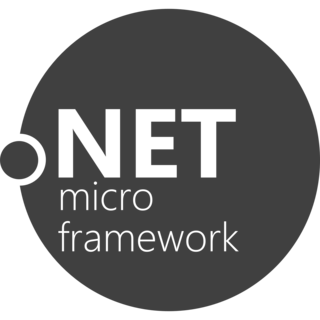
The .NET Micro Framework (NETMF) is a .NET Framework platform for resource-constrained devices with at least 512 kB of flash and 256 kB of random-access memory (RAM). It includes a small version of the .NET Common Language Runtime (CLR) and supports development in C#, Visual Basic .NET, and debugging using Microsoft Visual Studio. NETMF features a subset of the .NET base class libraries, an implementation of Windows Communication Foundation (WCF), a GUI framework loosely based on Windows Presentation Foundation (WPF), and a Web Services stack based on Simple Object Access Protocol (SOAP) and Web Services Description Language (WSDL). NETMF also features added libraries specific to embedded applications. It is free and open-source software released under Apache License 2.0.
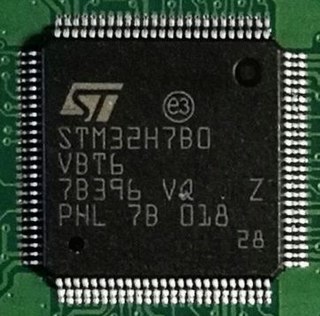
STM32 is a family of 32-bit microcontroller integrated circuits by STMicroelectronics. The STM32 chips are grouped into related series that are based around the same 32-bit ARM processor core: Cortex-M0, Cortex-M0+, Cortex-M3, Cortex-M4, Cortex-M7, Cortex-M33. Internally, each microcontroller consists of ARM processor core(s), flash memory, static RAM, debugging interface, and various peripherals.

LPC is a family of 32-bit microcontroller integrated circuits by NXP Semiconductors. The LPC chips are grouped into related series that are based around the same 32-bit ARM processor core, such as the Cortex-M4F, Cortex-M3, Cortex-M0+, or Cortex-M0. Internally, each microcontroller consists of the processor core, static RAM memory, flash memory, debugging interface, and various peripherals. The earliest LPC series were based on the Intel 8-bit 80C51 core. As of February 2011, NXP had shipped over one billion ARM processor-based chips.

Intel Quark is a line of 32-bit x86 SoCs and microcontrollers by Intel, designed for small size and low power consumption, and targeted at new markets including wearable devices. The line was introduced at Intel Developer Forum in 2013, and discontinued in January 2019.
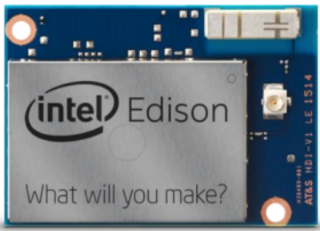
The Intel Edison is a computer-on-module that was offered by Intel as a development system for wearable devices and Internet of Things devices. The system was initially announced to be the same size and shape as an SD card and containing a dual-core Intel Quark x86 CPU at 400 MHz communicating via Bluetooth and Wi-Fi. A later announcement changed the CPU to a 500 MHz Silvermont dual-core Intel Atom CPU, and in September 2014 a second version of Edison was shown at IDF, which was bigger and thicker than a standard SD card.

The Arduino Uno is an open-source microcontroller board based on the Microchip ATmega328P microcontroller (MCU) and developed by Arduino.cc and initially released in 2010. The microcontroller board is equipped with sets of digital and analog input/output (I/O) pins that may be interfaced to various expansion boards (shields) and other circuits. The board has 14 digital I/O pins, 6 analog I/O pins, and is programmable with the Arduino IDE, via a type B USB cable. It can be powered by a USB cable or a barrel connector that accepts voltages between 7 and 20 volts, such as a rectangular 9-volt battery. It has the same microcontroller as the Arduino Nano board, and the same headers as the Leonardo board. The hardware reference design is distributed under a Creative Commons Attribution Share-Alike 2.5 license and is available on the Arduino website. Layout and production files for some versions of the hardware are also available.
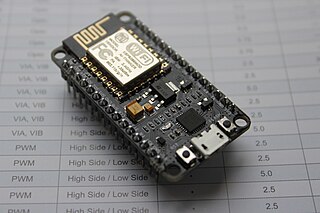
NodeMCU is a low-cost open source IoT platform. It initially included firmware which runs on the ESP8266 Wi-Fi SoC from Espressif Systems, and hardware which was based on the ESP-12 module. Later, support for the ESP32 32-bit MCU was added.
The MSP432 is a mixed-signal microcontroller family from Texas Instruments. It is based on a 32-bit ARM Cortex-M4F CPU, and extends their 16-bit MSP430 line, with a larger address space for code and data, and faster integer and floating point calculation than the MSP430. Like the MSP430, it has a number of built-in peripheral devices, and is designed for low power requirements. In 2021, TI confirmed that the MSP432 has been discontinued and "there will be no new MSP432 products".

The Arduino Nano is an open-source breadboard-friendly microcontroller board based on the Microchip ATmega328P microcontroller (MCU) and developed by Arduino.cc and initially released in 2008. It offers the same connectivity and specs of the Arduino Uno board in a smaller form factor.
MicroPython is a software implementation of a programming language largely compatible with Python 3, written in C, that is optimized to run on a microcontroller.
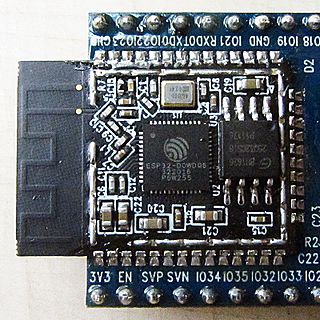
ESP32 is a series of low-cost, low-power system on a chip microcontrollers with integrated Wi-Fi and dual-mode Bluetooth. The ESP32 series employs either a Tensilica Xtensa LX6 microprocessor in both dual-core and single-core variations, Xtensa LX7 dual-core microprocessor or a single-core RISC-V microprocessor and includes built-in antenna switches, RF balun, power amplifier, low-noise receive amplifier, filters, and power-management modules. ESP32 is created and developed by Espressif Systems, a Chinese company based in Shanghai, and is manufactured by TSMC using their 40 nm process. It is a successor to the ESP8266 microcontroller.
ESP Easy is a free and open source MCU firmware for the Internet of things (IoT). and originally developed by the LetsControlIt.com community. It runs on ESP8266 Wi-Fi based MCU platforms for IoT from Espressif Systems. The name "ESP Easy," by default, refers to the firmware rather than the hardware on which it runs. At a low level, the ESP Easy firmware works the same as the NodeMCU firmware and also provides a very simple operating system on the ESP8266. The main difference between ESP Easy firmware and NodeMCU firmware is that the former is designed as a high-level toolbox that just works out-of-the-box for a pre-defined set of sensors and actuators. Users simply hook up and read/control over simple web requests without having to write any code at all themselves, including firmware upgrades using OTA updates.
Mongoose OS is an Internet of Things (IoT) Firmware Development Framework available under Apache License Version 2.0. It supports low power, connected microcontrollers such as: ESP32, ESP8266, TI CC3200, TI CC3220, STM32. Its purpose is to be a complete environment for prototyping, development and managing connected devices.
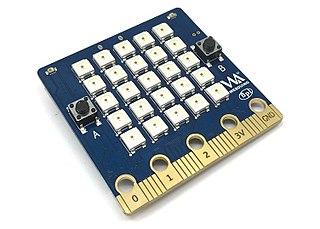
The BPI Bit is an ESP32 with Xtensa 32bit LX6 single/dual-core processor based embedded system

RP2040 is a 32-bit dual ARM Cortex-M0+ microcontroller integrated circuit by Raspberry Pi Ltd. In January 2021, it was released as part of the Raspberry Pi Pico board.





















